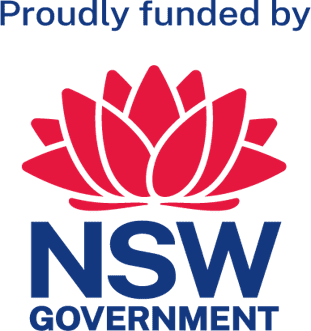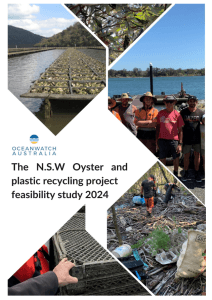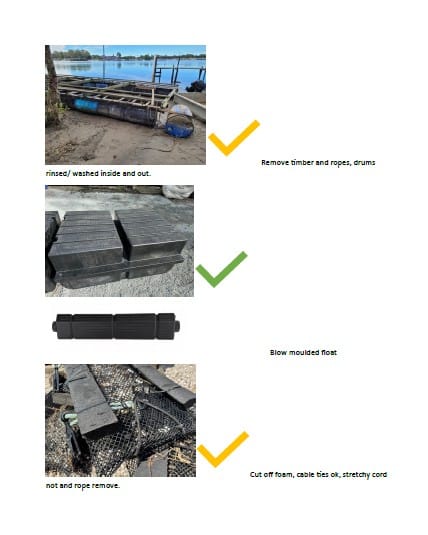The project “From Waste to Product - Identifying plastic and shell recycling pathways in the NSW oyster Industry” aims to transition the NSW Oyster industry to a more resilient business model, focused on partnering with recycling ventures to add value to waste and byproduct stockpiles.
The "From Waste to Product" project was developed in response to the devastating impacts of the February and March 2021 floods on the NSW oyster industry, which caused $17 million in damages, including stock loss, infrastructure destruction, and environmental degradation. The floods highlighted the urgent need for improved waste management practices, particularly for discarded/end of life plastic oyster infrastructure and oyster shells, which are often stockpiled or sent to landfill, posing environmental and financial risks. Additionally, flooding events exacerbate these issues by washing stockpiled gear into waterways, increasing marine debris and navigation hazards.
The project aimed to transition the NSW oyster industry to a more resilient and sustainable business model by addressing waste management challenges through circular economy principles.
It included three key initiatives:
- a feasibility study to identify cost-effective recycling solutions,
- statewide estuary clean-up events to recover lost infrastructure and debris, and
- trials of recycling options for oyster gear and shells.
The project sought to reduce waste, improve environmental stewardship, and create economic opportunities for oyster farmers. This comprehensive approach aligned with industry strategies and government priorities, fostering resilience, sustainability, and productivity in the NSW oyster sector. Advice and input direction was provided via a steering committee of oyster farmers, industry representatives, recycling practitioners, academics and government staff that met 4 times every 6 months.

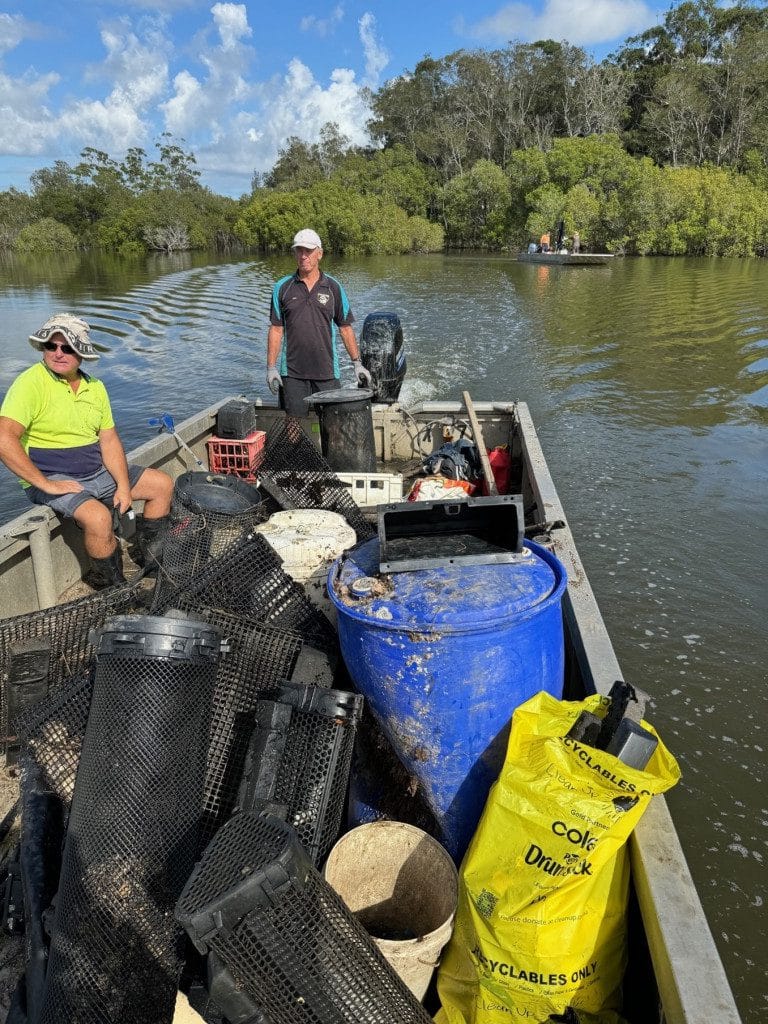
Feasbility Study
The research methodology for the project was documented in the NSW Oyster and Plastic Recycling Project Feasibility Study. It involved a comprehensive waste audit conducted in late 2023 across 20 estuaries, representing 61% of the NSW Priority Oyster Aquaculture Area. The audit aimed to quantify waste volumes, understand infrastructure life cycles, and assess disposal and recycling practices. Data collection included surveys with 48 respondents, covering oyster farming systems, equipment lifespan, maintenance routines, and waste management practices.
The audit utilized a structured questionnaire with 26 questions, designed for both remote and in-person completion, ensuring consistency and depth in responses. Key metrics included stockpiled plastic waste (126 tonnes estimated statewide) and shell waste (4,425 tonnes annually). The study also extrapolated future waste projections based on current production volumes and infrastructure usage.
This study looked to quantify the waste situation and seek both to action an immediate reduction of stockpiled waste while progressing discussions on a circular economy end goal.
The report recommends:
• Ensuring this grant provides an immediate reduction to the waste stockpiles.
• Now that waste volumes are better understood, move beyond landfill to seeking/supporting plastic recyclers who can economically use the waste. Improve handling practices that maximise its value to a recycler and continue to seek interested parties if limited opportunities exist currently, recognising that the marketplace is evolving.
• Deriving new value from waste resources through investing in joint research innovations with academia and importantly end user industry who can capitalise on findings.
• Encouraging infrastructure manufacturers to consider end of life in their future designs.
• Seeking higher value uses for waste oyster shell by filling in gaps of knowledge and trialling treatment options to reduce contamination.
• Labelling oyster infrastructure for ease of recovery and enabling software to return post flood items to growers.
• Removing legacy tar treated timber posts and trays to landfill through subsidy after considering use in energy production.
• Recognising with growing scientific literature and concern over the impacts of plastics in ecosystems and human health the oyster industry may need to advance material use in the near future away from plastics.
Read the report here!
Recycling Implementation
The feasibility study identified a number of scenarios that will enable potential flood debris plastics to be collected and removed from estuaries.
Over 3 weeks in March 2025 a mobile shredding team worked with Oyster farmers and OceanWatch across the state to prepare, shred and transport hard plastic to a processor in Sydney. This resulted in:
• Tackling 30 tonnes of the predicted 126-tonne plastic stockpile
• Volume pre shred estimated at 30 truckloads or ½ a football field at 2m height
• 102 CM (four 20 ft shipping containers or enough for Forty-two 1 tonne HiLux’s) removed
• 11 estuaries were serviced, spanning a total distance of 1,472 kilometres between them
• Around 40 farmers contributed waste. (15% of NSW Industry)
• 17 days over 3-week period for 32 shredded bags (1.7CM each) working 8–12-hour days
• Above contributed $898k in in-kind farmer/ worker contributions assisting and preparing infrastructure
OceanWatch set up a relationship with a recycler in Sydney that took the material at no cost and then processed, cleaned and pelletized batches to on sell to a manufacturer. It is hoped this relationship can continue beyond the grant if oyster farmers are able to stockpile like items together and process them in a way that retains value for this recycler and allows a continuation towards future mobile shredding and transport costs. Realistically this work requires its own subsidy or cost to the farmer for the operation to be viable. Check in with OceanWatch on any upcoming initatives.
To see what was accepted for recycling in March 2025 click here.
Timber tipping subsidy
Tarred and treated timber cultivation gear was identified as a flood risk and its removal from estuaries free up space for more productive uses given many leases have converted to plastic based cultivation infrastructure. OceanWatch realise this process is expensive so have looked for ways to lessen the burden while seeking to implement circular economy principles.
Conversion to energy via power station utilisation was investigated however remains nonviable.
• 359 tonnes of timber arrived at the landfill over 178 trip journeys’ involving 3 rounds of subsidy.
Tide to tip estuary clean ups
During the project there was a focus on encouraging the oyster industry to lead estuary cleans up backed by professional OceanWatch facilitation.
• 50 estuary cleanups (2 leveraging corporate engagement) an additional 13 on the target.
• Across the 3 years- 28.5 tonnes removed by 477 volunteers (374 of which were farmers) over 1428 volunteer hours.

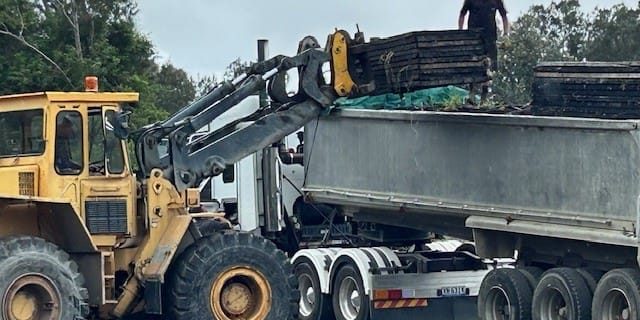
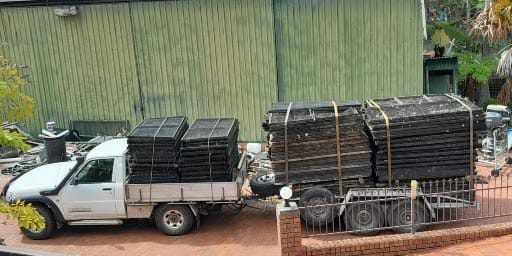
The project is directed by a steering committee of professionals from the oyster, recycling, and natural resource management sectors.
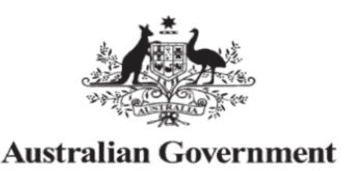
The development of this Feasibility Study was supported through joint funding by the Australian and NSW
Government’s Storm and Flood Industry Recovery Program. “Although funding for this product has been provided by
both Australian and NSW governments, the material contained herein does not necessarily represent the views of either
Government.”
